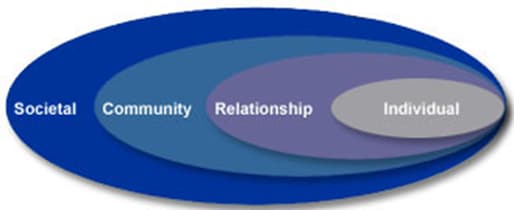The DELTA FOCUS Program: Intimate Partner Violence is Preventable
Archived
About the Program
Intimate partner violence (IPV) is a serious, preventable public health problem that affects millions of Americans and results in serious consequences for victims, families, and communities.
- In the United States, 32.4% of women and 28.3% of men report experiencing physical violence by an intimate partner in their lifetime.1
- Among those who ever experienced rape, physical violence, or stalking by an intimate partner, approximately 7% of women and 4% of men have experienced some form of IPV for the first time before 18 years of age.1
- In an average minute, about 29 people are victims of rape, physical violence, or stalking by an intimate partner.1
- In 2015, 1270 women and men were murdered by an intimate partner (e.g. husband, wife, boyfriend, girlfriend).2
Primary prevention of IPV means stopping it before it occurs. DELTA FOCUS (Domestic Violence Prevention Enhancements and Leadership Through Alliances, Focusing on Outcomes for Communities United with States) is a five-year cooperative agreement funding 10 state domestic violence coalitions to engage in primary prevention of IPV.
Use the map to access the website of CDC-funded state domestic violence coalitions.
For additional information on prevention activities based on the best available evidence, please see the Division of Violence Prevention’s IPV prevention technical package [PDF 4.52MB].3
For additional information on why IPV is an important public health issue, see our web page Intimate Partner Violence.
The DELTA FOCUS Program
Since 2013, DELTA FOCUS grantees have worked to prevent IPV at the national, state and local levels by implementing strategies to change the environments and conditions in which people live, work and play. To do this, grantees address economic and social policies, processes, and norms that shape the lives of individuals and communities. This involves implementing strategies that impact issues such as education, employment, reducing gender bias, and more.
Each grantee supports one or two coordinated community response teams (CCRs) to implement strategies at the local level. CCRs are local coalitions comprised of members from a variety of sectors (e.g., health care providers, the education community, faith-based communities, the criminal justice system, etc) engaged in IPV prevention. Sixteen CCRs are supported by DELTA FOCUS.
DELTA FOCUS Goals and Strategies
DELTA FOCUS grantees are implementing strategies that prevent IPV in order to ultimately:
- Reduce the occurrence of IPV through the promotion of healthy, respectful, nonviolent communities and relationships
- Reduce known risk factors and promote protective factors for IPV (see Intimate Partner Violence: Risk and Protective Factors for the CDC’s risk and protective factors page)
Common strategies used by DELTA FOCUS grantees to prevent IPV include:
- Changing gender and violence social norms
- Informing policy and systems change
- Mobilizing communities
- Developing youth assets (e.g., healthy decision-making skills and leadership skills, positive peer and family relationships)
- Promoting healthy relationships and communication skills
- Engaging men and boys in violence prevention
- Encouraging bystander intervention
- Building coalitions
Program Concepts
- Primary Prevention: Approaches that take place before IPV has occurred. Prevention strategies are guided by a set of principles including:
- Preventing first-time perpetration and first-time victimization
- Reducing risk factors associated with IPV
- Promoting protective factors that reduce the likelihood of IPV
- Implementing evidence-supported strategies that incorporate behavior change and social change theories
- Evaluating prevention strategies
- Using results to inform future plans
- Social-Ecological Model: A four-level model that considers the complex interplay between individual, relationship, community, and societal factors and allows us to address the factors that put people at risk for perpetrating or experiencing violence. Learn more about the social-ecological model

- Social Norms Change: Changes to the informal, shared beliefs and standards of behavior within a community with regard to violence and relationships.
- Social Determinants of Health: The conditions in which people are born, grow, live, work and age that influence their opportunities for a healthy, productive life. These circumstances are shaped by access to money, power, and resources at global, national and local levels. The social determinants of health contribute to health inequities – the unfair and avoidable differences in health status seen within and between countries.
- Structural Determinants of Health: The economic and social policies, processes and norms that structure opportunities for the health of individuals, communities, and jurisdictions; they include but are not limited to equitable access to quality early childhood development opportunities, education, employment/jobs with livable wages, food security, health services, housing, safe neighborhoods, and social inclusion.
- Empowerment Evaluation: “Empowerment evaluation places an explicit emphasis on building the evaluation capacity of individuals and organizations so that evaluation is integrated into the organization’s day-to-day management processes… Empowerment evaluators coach individuals and organizations through an evaluation of their own strategies by providing them with the knowledge, skills, and resources they need to conduct just such an evaluation.”4
History

In 2002, authorized by the Family Violence Prevention Services Act (FVPSA), CDC developed the Domestic Violence Prevention Enhancements and Leadership Through Alliances (DELTA) Program to focus on primary prevention of IPV. For the next 10 years, DELTA funded state domestic violence coalitions to engage in statewide primary prevention efforts and to provide training, technical assistance, and financial support to local communities for primary prevention efforts.
DELTA (2002-2013) built capacity for IPV primary prevention in 14 funded state domestic violence coalitions, their local CCRs and at the state level. Stakeholders were identified and partnerships were built that did not exist prior to DELTA. Empowerment evaluation was used to assess capacity-building efforts and programmatic activities.
During the latter years of DELTA, another project was implemented: DELTA PREP (Preparing and Raising Expectations for Prevention. DELTA PREP) was supported from 2008-2011 by the Robert Wood Johnson Foundation in collaboration with the CDC and the CDC Foundation. The DELTA PREP project provided an additional 19 SDVCs with training, technical assistance and other resources to incorporate primary prevention into their organizational, local and state IPV efforts.
DELTA and DELTA PREP offered many lessons learned, including the importance of capacity building at local, state, and organizational levels; the importance of ongoing program evaluation and continuous quality improvement; the importance of working at all levels of the social ecology; and the importance of concentrating resources (saturation) for greater impact.
The DELTA FOCUS (2013-2018) Program builds on DELTA’s history by providing focused support to states and communities for intensive implementation and evaluation of IPV primary prevention strategies that address the social and structural determinants of health at the societal and community levels of the social-ecological model (SEM).
While DELTA FOCUS grew from, and builds on, DELTA and DELTA PREP, it differs in the following key ways:
- Greater emphasis implementing prevention strategies, and less on initial capacity building (the project works with grantees who are already at high capacity)
- Increased focus on program evaluation to help increase our understanding of what works to prevent IPV
- Reformulation of local partner groups into larger coalitions for the purpose of building and/or supporting primary prevention work.
DELTA FOCUS directs limited resources for maximum impact, building upon previous efforts and highlighting the project’s success and contributions to the field.
For more information on the history of the DELTA program, visit our Web page.
National Engagement
CDC is working with the Family Violence Prevention and Services Office of the Administration for Children and Families and the National Resource Center on Domestic Violence to foster leadership and support for primary prevention throughout the IPV field. This includes any and all state, territorial, and tribal domestic violence coalitions; local programs; national organizations; and allied partners interested in advancing IPV prevention. Some key activities related to this goal include:
- Telling the story of current and former IPV prevention initiatives and promoting emerging best practices, tools, and resources
- Linking STTDVCs, local programs, national partners and other allies interested in enhancing the national dialogue on prevention through an effective and inclusive online community of practice with PreventIPV.org.
- Providing support and technical assistance to the IPV Prevention Council (see http://www.preventipv.org/ for more information) in its development of a primary prevention enhancement strategies and implementation plan
Evaluation and Resources

Publications
- Armstead, T., Rambo, K., Kearns, M., Jones, K.M., Dills, J., & Brown, P. (2017). CDC’s DELTA FOCUS Program: Identifying Promising Primary Prevention Strategies for Intimate Partner Violence. Journal of Women’s Health, 26(1), 9-12.
- Armstead, T.L., Kearns, M., Rambo, K., Estefan, L., Dills, J., Rivera, M., & El-Beshti, R. (in press). The Use of the Data-to-Action Framework in the Evaluation of CDC’s DELTA FOCUS Program. Journal of Public Health Management and Practice.
Resources
- Performance and Program Evaluation Office website: https://www.cdc.gov/eval/
References
- Smith, S.G., Chen, J., Basile, K.C., Gilbert, L.K., Merrick, M.T., Patel, N., Walling, M., & Jain, A. (2017). The National Intimate Partner and Sexual Violence Survey (NISVS): 2010-2012 State Report. Atlanta, GA: National Center for Injury Prevention and Control, Centers for Disease Control and Prevention.
- United States Department of Justice, Federal Bureau of Investigation. (September 2016). Crime in the United States, 2015. Retrieved September 23, 2017, from https://ucr.fbi.gov/crime-in-the-u.s/2015/crime-in-the-u.s.-2015/tables/expanded_homicide_data_table_10_murder_circumstances_by_relationship_2015.xls
- Niolon, P. H., Kearns, M., Dills, J., Rambo, K., Irving, S., Armstead, T., & Gilbert, L. (2017). Preventing Intimate Partner Violence Across the Lifespan: A Technical Package of Programs, Policies, and Practices. Atlanta, GA: National Center for Injury Prevention and Control, Centers for Disease Control and Prevention.
- Cox PJ, Keener D, Woodard T, Wandersman A. (2009). Evaluation for Improvement: A Seven Step Empowerment Evaluation Approach for Violence Prevention Organizations. Atlanta, GA: Centers for Disease Control and Prevention). Available at http://www.cdc.gov/violenceprevention/pdf/evaluation_improvement-a.pdf [PDF 2.85MB].